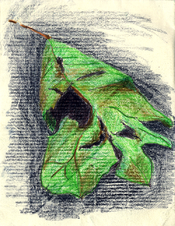Sunset, Monday, 21 September 2009
 William Theodore Van Doren. Stony Point, Albemarle County, Va. Oil on paper, 16 x 20.
William Theodore Van Doren. Stony Point, Albemarle County, Va. Oil on paper, 16 x 20.
I think I might be issuing my final report of the year about sumac, having opened this little can of mysteries in two posts, on July 29th and August 5th. As I have previously observed, sumac is quite the hot topic ... somewhere ... maybe. I actually did receive one note of appreciation from a reader who, while I guess she didn’t describe herself as an outright fan or aficionado of sumac, at least didn’t consider the subject to be beneath notice. Or maybe it would be more accurate to say she didn’t seem to consider it beneath the standards of this blog.
Anyway, today on my walk with Flint, as we got down near the [Rivanna] river, in the so-called Scrubby Field, I realized that the ubiquitous sumac trees or bushes had gone through many of their changes for the coming autumn, including their leaves beginning to turn bright red. In the plants that had originally caught my attention – which turned out to be the females – with their flower clusters changing from small green dots to magenta buds emerging out of gold petals – the clusters had over the past several weeks turned a sort of violet raspberry, then a deep red grape, and now a dark rust red. In the middle of that sequence, the buds seemed plumped with life, with a vibrant slightly waxy sheen. They still retain some of that healthy shine.
Meanwhile, you might recall I was beginning to realize the fields were also filled with male plants, with clusters that looked generally similar to the others at first, except instead of fat furled buds these were rather simple yellow flowers, each with five gold stamens. At one point during August I couldn’t walk through the field without wading through shoulder-high braces of yellow sumac laden with buzzing bumblebees and honeybees, the bees stuck all golden underneath with pollen.
With the passing weeks it became clear that the male flowers were being pretty much devastated and laid low by the pollen harvest, while the female sumac clusters were attaining the height of their beauty. I really don’t want to give Camille Paglia any more reason to gloat, but the guy flowers were wasted – looking literally burnt down to dark nubs.
Now the male sumac trees have no flowers at all, and the female trees are showing the shaggy dark red clusters so familiar in autumn.
And since there’s an obvious male-female subtext to this story, I can’t resist mentioning one more thing. Weeks after I ‘discovered’ these (to me) exotic sumac phenomena down by the river, about three miles from the house, I found that the whole time we had both kinds of sumac right outside the entrance to our front yard, where I had passed them every day without noticing.
Which illustrates (perhaps) that Man (or man) will sometimes pay attention to things only when they’re found elsewhere, at a distance, and miss them if they’re right in front of him.
Hear, hear! (Here, here.)
 Monday, September 21, 2009 at 08:05PM | by
Monday, September 21, 2009 at 08:05PM | by  BVD | in
BVD | in  Sunset Paintings | tagged
Sunset Paintings | tagged  Blue Ridge,
Blue Ridge,  Camille Paglia,
Camille Paglia,  Flint the foxhound,
Flint the foxhound,  Rivanna River,
Rivanna River,  sumac | | Comments Off
sumac | | Comments Off 




